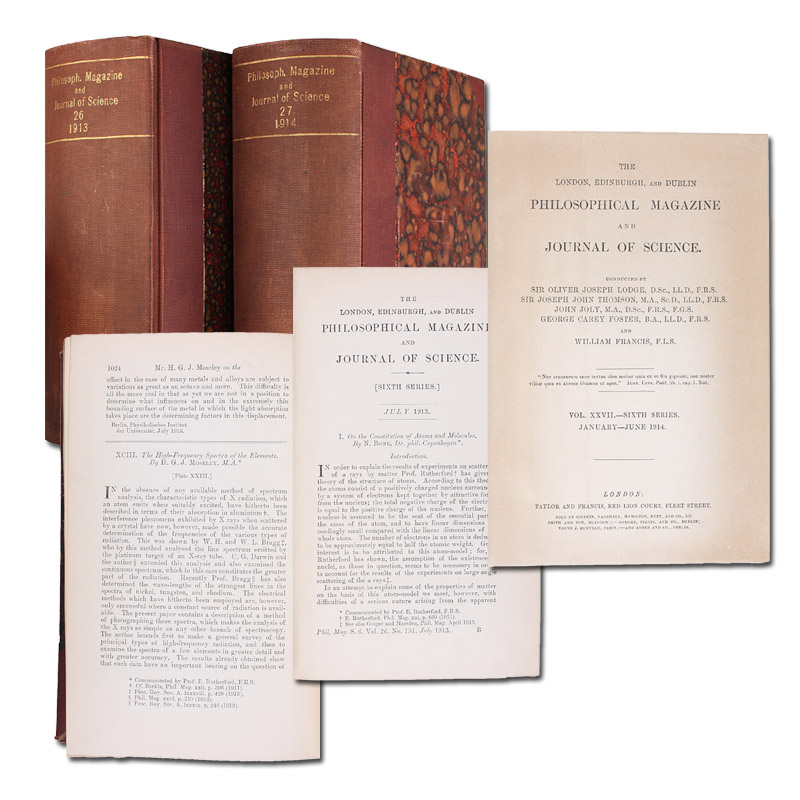102978-01
The high-frequency spectra of the elements. 2 Teile. SS. 1024-1034 und 703-713. Mit 4 Abbildungen und 1 Tafel. - Und: N(iels) Bohr. On the constitution of atoms and molecules. SS. 1-25, 476-502 und 857-875. In: Philosophical Magazine, 6th series. Vol. 26 und 27.
London, Taylor & Francis, 1913-14. - (20 x 14 cm). VIII, 1064 S./ VIII, 1044 S. Mit zahlreichen Abbildungen, 41 Tafeln und 1 Tabelle. Halbleinwandbände der Zeit.
Zu I: Erste Ausgabe von Moseleys berühmter Arbeit zur Bestimmung der Ordnungszahl der Elemente, ein Meilenstein in der Entwicklung der Atomphysik. - "Moseley, working under Rutherford in Manchester, used the method of X-ray spectroscopy devised by the Braggs to calculate variations in the wavelength of the rays emitted by each element. These he was able to arrange in a series according to the nuclear charge of each element. Thus if the nuclear charge of hydrogen is 1, in helium it is 2, in lithium 3, and so on by regular progression to uranium as 92. These figures Moseley called atomic numbers. He pointed out that they also represented a corresponding increase in extra-nuclear electrons and that it is the number and arrangement of these electrons rather than the atomic weight that determines the properties of an element. It was now possible to base the periodical table on a firm foundation, and to state with confidence that the number of elements up to uranium is limited to 92. When Moseley's table was completed, six atomic numbers had no corresponding elements; but Moseley himself was able to predict the nature of four of the missing elements" (PMM). - DSB 9, 542; PMM 407; Norman 1559. - Zu II: Erste Ausgabe dieser bedeutenden Arbeit zur Verbesserung von Rutherfords Atommodell. - "Bohr's three-part paper postulated the existence of stationary states of an atomic system whose behavior could be described using classical mechanics, while the transition of the system from one stationary state to another would represent a non-classical process accompanied by emission or absorption of one quantum of homogeneous radiation, the frequency of which was related to its energy by Planck’s equation" (Norman). - DSB 2, 239; PMM 411; Norman 258. - Vorsätze gestempelt. Einbände gering berieben. Rücken leicht fleckig. Insgesamt gut erhaltenes und nahezu fleckenfreies Exemplar
The high-frequency spectra of the elements. 2 Teile. SS. 1024-1034 und 703-713. Mit 4 Abbildungen und 1 Tafel. - Und: N(iels) Bohr. On the constitution of atoms and molecules. SS. 1-25, 476-502 und 857-875. In: Philosophical Magazine, 6th series. Vol. 26 und 27.
London, Taylor & Francis, 1913-14. - (20 x 14 cm). VIII, 1064 S./ VIII, 1044 S. Mit zahlreichen Abbildungen, 41 Tafeln und 1 Tabelle. Halbleinwandbände der Zeit.
Zu I: Erste Ausgabe von Moseleys berühmter Arbeit zur Bestimmung der Ordnungszahl der Elemente, ein Meilenstein in der Entwicklung der Atomphysik. - "Moseley, working under Rutherford in Manchester, used the method of X-ray spectroscopy devised by the Braggs to calculate variations in the wavelength of the rays emitted by each element. These he was able to arrange in a series according to the nuclear charge of each element. Thus if the nuclear charge of hydrogen is 1, in helium it is 2, in lithium 3, and so on by regular progression to uranium as 92. These figures Moseley called atomic numbers. He pointed out that they also represented a corresponding increase in extra-nuclear electrons and that it is the number and arrangement of these electrons rather than the atomic weight that determines the properties of an element. It was now possible to base the periodical table on a firm foundation, and to state with confidence that the number of elements up to uranium is limited to 92. When Moseley's table was completed, six atomic numbers had no corresponding elements; but Moseley himself was able to predict the nature of four of the missing elements" (PMM). - DSB 9, 542; PMM 407; Norman 1559. - Zu II: Erste Ausgabe dieser bedeutenden Arbeit zur Verbesserung von Rutherfords Atommodell. - "Bohr's three-part paper postulated the existence of stationary states of an atomic system whose behavior could be described using classical mechanics, while the transition of the system from one stationary state to another would represent a non-classical process accompanied by emission or absorption of one quantum of homogeneous radiation, the frequency of which was related to its energy by Planck’s equation" (Norman). - DSB 2, 239; PMM 411; Norman 258. - Vorsätze gestempelt. Einbände gering berieben. Rücken leicht fleckig. Insgesamt gut erhaltenes und nahezu fleckenfreies Exemplar
2.000 €

